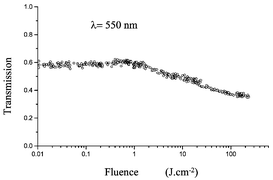Photochromic compounds as optical limiters in the nanosecond time range: the example of mercury dithizonate complex†
Abstract
Although being an efficient photochromic compound which absorbs in the blue in its stable form and in the orange in its photoactivated form, the mercury dithizonate complex is shown to be a poor optical limiter for nanosecond laser pulses at the wavelengths where both isomers absorb. Optical limiting effect, which is a consequence of reverse saturable absorption due to the photoactivated form, is demonstrated to be weak because of the back photobleaching of this form, which is important all the more as the laser intensity is high. Numerical integration of the spatio-temporal evolution of the laser beam intensity across the solution helps the understanding of the respective roles of the laser fluence and pulse duration. Finally, we draw the conclusion that photochromic compounds can only be used as optical limiters if the time constant for the back photochemical reaction is slow compared to the pulse duration.

- This article is part of the themed collection: In honour of Jean Kossanyi

 Please wait while we load your content...
Please wait while we load your content...